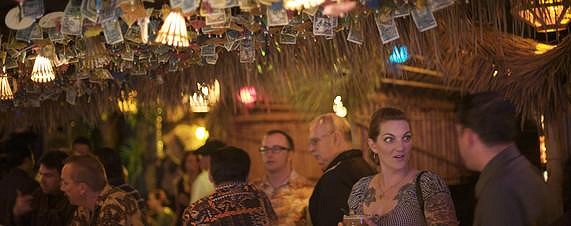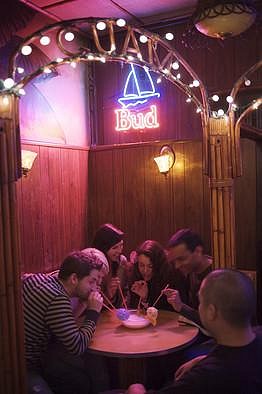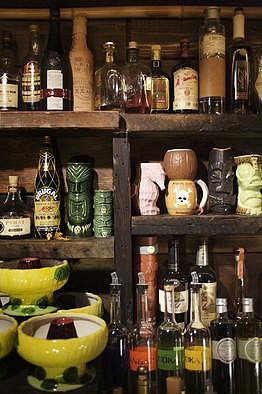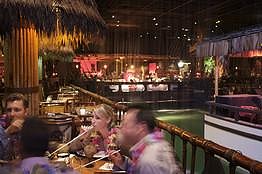Tiki Central / General Tiki / Wall Street Journal on October 4th, 2008
Post #411945 by Monkeyman on Mon, Oct 6, 2008 9:34 AM
|
M
Monkeyman
Posted
posted
on
Mon, Oct 6, 2008 9:34 AM
Tiki Doesn't Have to Be Tacky With the much-repeated words "worst financial crisis since the Great Depression" marking the moment, it seems appropriate to visit that peculiarly American escape -- the tiki bar -- itself born in the depths of the Depression. It was in 1934 that Donn Beach (né Ernest Raymond Beaumont-Gantt) opened Don the Beachcomber in Los Angeles, starting a craze that took roughly 50 years to fizzle. The time seems ripe for a Polynesian Pop revival -- and, in fact, it's already under way. Starting Thursday, and going through next Sunday, tikiphiles will be descending on the San Francisco Bay area for the eighth annual Tiki Bar Crawl. The Bay Area was one of the original hot spots of tikiana: Victor Bergeron owned an Oakland barbecue place called Hinky Dinks; after visiting Don the Beachcomber's place in L.A., Bergeron promptly bedecked his restaurant with tiki carvings, bamboo and outrigger canoes and rechristened it "Trader Vic's." The Bay area is still home to a remarkable number of tiki bars, big and small, old and new. That's why the community of tiki fanatics -- who normally gather online at aficionado Hanford Lemoore's Web site, http://www.tikicentral.com -- make San Francisco and Oakland their destinations to meet and drink in person. Go to http://www.tikicrawl.com to find out when and where to join them.
Polynesian Pop was also an eminent variety of Americana. When Nikita Khrushchev and his wife visited San Francisco in September 1959, Madame Khrushchev slipped away from her official minders and went off to experience America first-hand. She shopped at Sears and lunched at Trader Vic's. When Queen Elizabeth II visited California in 1983, it was at Trader Vic's that the Reagans took her to dine. But by then the island fad was finally petering out. When Donald Trump bought the Plaza in 1988, one of his first edicts was to shutter Trader Vic's, which he said had "gotten tacky." And he would know. I suspect that the last time a tiki bar was on the radar of most Americans was in the movie "GoodFellas." Joe Pesci unleashes his infamous rant -- "I amuse you?" -- in the Bamboo Lounge, which he and Ray Liotta soon torch. That thatch inferno was a sort of funeral pyre for Polynesian Pop. But the tiki aesthetic remains embedded in our collective subconscious. How many of us grew up watching "Gilligan's Island" reruns? Nowadays, I share with my 4-year-old son a taste for "SpongeBob SquarePants" (in which SpongeBob and his crochety co-worker Squidward both live in houses that appear to be modeled after tiki-bar mugs). Twenty-somethings have embraced Polynesian Pop in their own way, adorning themselves with Maori tribal tattoos. And even through the lean years of the past two decades, some of the great old tiki joints managed to survive, among them the magnificent Mai-Kai in Fort Lauderdale, Fla., and the intimate Tiki-Ti in L.A.
Photography by John Lee/Aurora Select for The Wall Street Journal The tiki-craze may have reached its zenith in the late '50s and early '60s, but there's a new allure to the escape it promises. What are we escaping now? The financial woes may be the best excuse of the moment, but tiki provides an escape somewhat more fundamental, a vacation from the everyday, even if today's bears little resemblance to the everyday of the '50s. We aren't quite the gray-flannel-suiters we used to be, and who used to be tiki's prime devotees. Richard Nixon -- famous for, among other things, wearing a dark suit and wingtips when strolling the beach at San Clemente -- found solace in the Polynesian fantasy that was the old Trader Vic's in Washington's Capitol Hilton. There was a guy who could use an escape. Ever since the cultural revolution of the late '60s and '70s, we no longer need an island retreat to loosen our ties (how many of us even know how to tie them anymore?). But that doesn't mean there isn't a place for tiki. In a way, the slacker aesthetic has ruined loafing -- who wants to spend his life clad in dingy sweats living in his parents' basement? Donn Beach's brand of indolence was decidedly stylish by comparison. His was not a lethargy born of surly diffidence. He championed island-style relaxation as a sybaritic art form: "Of ALL Life's Pleasures deeply drink/At every worry give a wink/It's MUCH MUCH later than you think," went the official Beachcomber's Creed. I suspect Donn would have frowned at the technological tethers -- cellphones, BlackBerries and such -- that bind us to our workaday world. We live in an obnoxiously insistent age, with its relentless blog slog and the Sisyphean ordeal of answering emails. This tyranny of hyper-connection may be why tiki culture has a new resonance -- the promise of being detached from the cyber-grind. A thatched hut on some forgotten atoll is the sort of place alluring in its lack of cell coverage.
Happily, those making the crawl this next week in the Bay area will enjoy a remarkable amount of good tiki. In Oakland there is the Conga Lounge, where the house special is a decent coconut-rum drink called the Gilligan's Island, in keeping with the kooky castaway atmosphere of the bar. Far more polished is the vibe you get at the Kona Club. Not much to look at from the outside, it is a bamboo palace on the inside, dignified by a life-size bronze mea hula whose grass skirt swivels on mechanical hips. Dangerously close to camp? Perhaps -- but it is done with such grace and elegance that all thoughts of glib postmodernism melt away. If only the drinks at Kona Club were up to the standard set by the metal goddess. By way of soliciting a recommendation, I asked the bartender her favorite among the tiki quaffs on the menu. "I don't drink these drinks," she replied. "I don't like rum." You won't have that problem at Forbidden Island, out in the San Francisco Bay on the island of Alameda. Though it is only two years old, Forbidden Island is as close as you will come to a tiki bar of World War II vintage, right down to the dollar bills pinned to the ceiling above the long bar. (Soldiers and sailors about to ship out would traditionally write their names on bills and stick them to the wall of a bar to be sure to have the money for a drink on their return.) Forbidden Island has a shipwreck subtext, as if constructed out of the remains of a string of reefed tiki bars. And indeed, the cozy place is awash with flotsam salvaged from all the great Polynesian palaces that sank decades ago. But what makes Forbidden Island a thing of beauty are the drinks. Long before tiki became officially tacky, it lost its emphasis on good taste -- that is, on the taste of the drinks. Donn Beach and Trader Vic both jealously guarded the secret recipes for the fantastical concoctions they served across their bars. But that didn't stop imitators from throwing any and every tropical juice together with some rum and calling it a Zombie or a Mai Tai. The "umbrella drink" became an icon for sugary slop. The best tiki drinks are, like any good cocktail, balanced. They are also complex. Tart citrus leavens the sweetness of tropical fruits; island spices like cinnamon, nutmeg and all-spice add mystery; and rums of various weights, potencies and flavors are combined to create depth. All this, served in a grimacing, flower-festooned totem pole of a mug. Forbidden Island proprietor Martin Cate has applied the new high-end-cocktail-culture insistence on hand-crafting and fresh ingredients to old, long-lost recipes unearthed by tiki-drink archaeologist Jeff "Beachbum" Berry. The results are fantastic, such as the Nui Nui, a delicious Don the Beachcomber original that has been reborn at Forbidden Island. Mr. Cate is also building on the tiki tradition of creating proprietary drinks with secret recipes. My favorite quaff at Forbidden Island is the eponymous house special. Sadly, copious pleading failed to wheedle the recipe out of Mr. Cate's hands: To enjoy a Forbidden Island, you'll have to visit the Alameda oasis of the same name. Mr. Cate has found the formula for a successful tiki revival, with brilliant drinks as the main ingredient. Even so, some tiki joints have survived on sheer nostalgia, in spite of the drinks. Trad'r Sam's on Geary Street in San Francisco may well be the oldest continually operating tiki bar in the country, having opened in the first flush of Polynesiana. The bamboo is sparse and tattered, but it helps make for a cheerful dive. The house specialty is a bland version of Trader Vic's Scorpion Bowl served in clear plastic bowls that might well have come from the salad bar at a Sizzler. The drinks are better at San Francisco's grandest tiki institution, the Tonga Room, established in the basement of the swanky Fairmont Hotel after World War II. I enjoyed a perfectly respectable concoction served in the shell of a fresh pineapple, and proceeded to soak up the dramatic atmosphere -- the impression of being in the high-vaulted thatched hut of an island potentate, complete with lagoon and the occasional indoor rainstorm. But the spell was broken before it was cast. I wish I could say that the sullen service was the only sore spot; but, alas, the waiters had good reason to scowl, regularly subjected as they are to the deafening band that floats out on a launch in the lagoon. Savvy tiki drinkers have learned to visit the Tonga Room early in the evening so as to escape before being assaulted with such wedding-band atrocities as "Brick House." This year's Tiki Crawl will conclude, appropriately enough, at the flagship Trader Vic's on the San Francisco Bay in Emeryville. When I visited a couple of weeks ago, I tried the Trader Vic's Grog -- a drink that is a favorite of the bar's crew -- and I was pleasantly surprised by how well-made it was, with island spices nicely balancing the fruit, and neither eclipsing the rum. But if you make it to next week's official Tiki Crawl, or just engineer a crawl of your own when time permits, you may want to indulge in the quintessential rite of tiki exotica and order the Trader's Scorpion Bowl for four -- slurped communally through impossibly long straws. Will the tiki-revival flourish? Perhaps -- especially if more places follow the lead of Mr. Cate and his Forbidden Island crew, concocting compelling drinks that can't be found anywhere but at a tiki bar. I certainly hope it will, because goodness knows we could all use an escape. For those of us not quite ready for the full Gauguin, a respite at Forbidden Island will do the trick nicely. The Nui Nui at the Forbidden Island bar. The Forbidden Island at the Forbidden Island bar. The Pineapple Royal at the Tonga Room. A version of the Scorpion Bowl at Trader Vic's.
Recipes 2 oz medium-bodied aged rum½ ?189 oz fresh lime juice½ oz fresh orange juice¼ oz cinnamon-infused syrup¼ oz vanilla-infused syrup¼ oz allspice liqueur1 dash Angostura bitters.Shake vigorously with ice and strain into a tall Collins glass with crushed ice. Even better if you give it just a couple of seconds in the blender. Garnish with a sprig of mint and an orange twist. For the syrups, try the Sonoma Syrup Co. (www.sonomasyrup.com) or your local Starbucks. If your local liquor store doesn't have allspice liqueur, ask them to check with importer Haus Alpenz. Scorpion Bowl (for 4) 6 oz white rum2 oz brandy1 oz gin3 oz fresh lemon juice3 oz fresh orange juice2 oz orgeat (an almond-flavored syrup)Shake with ice and strain into a bowl with fresh ice. Garnish with a gardenia floating in the middle of the bowl. Drink through impossibly long straws that allow all four of you to access the bowl at once. It's an instant tiki party! Mr. Felten is the author of "How's Your Drink?: Cocktails, Culture and the Art of Drinking Well" (Agate Surrey). Email him at [email protected]. |








